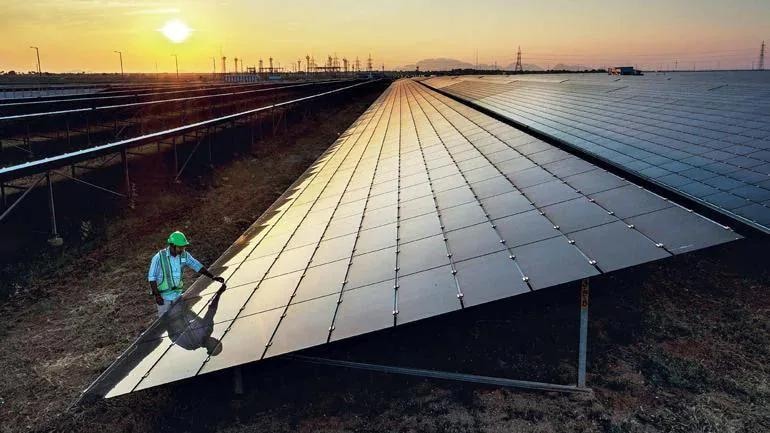
The Ministry of New and Renewable Energy (MNRE) has said that India is set to achieve 450 GW of renewable energy installed capacity by 2030.
Earlier this month, the MNRE, in partnership with FICCI, organised a series of events, from October 6-8 during the Climate and Biodiversity Week at Expo 2020 Dubai.
The events covered themes like ‘India’s Renewable Energy Achievements and Ambitions; Emerging Areas and Opportunities for Renewable Energy in India. The events were anchored by the Solar Energy Corporation of India (SECI) and the Indian Renewable Energy Development Agency (IREDA).
Addressing the MNRE-FICCI SECI event, RK Singh, Minister of Power, New and Renewable Energy, emphasised that the world is on the cusp of transformation, and immediate corrective steps are needed to mitigate climate change.
He highlighted that energy transition needs to be the first step in this direction.
He said that India is already ahead of what “we pledged in our Nationally Determined Contributions (NDCs)” and added that, “already 39 per cent of our installed capacity is from non-fossil based sources. By 2022 we will reach our target of 40 per cent”.
“India is set to achieve 450 GW of renewable energy installed capacity by 2030,” an MNRE statement said.
Highlighting that transmission is a challenge and getting it into place is a work in progress, the minister said, “We are launching the Green Corridor Phase 2 and we are generally expanding transmission to put in place systems for renewable power evacuation from sites where irradiation is high, or wind speed is high.”
Singh also said that, intermittency of renewable power is another challenge for the entire world, highlighting that battery storage per unit is currently high and needs to come down.
He added that the government is coming out with bids for battery storage.
There is a Production Linked Incentive for battery storage already in place and demand needs to be encouraged to bring down the prices of storage, Singh added.
Speaking on the opportunities for green hydrogen in India, Singh said, MNRE will work out with bids for electrolysers and that mandates for green hydrogen consumption in refining, fertilizer, piped natural gas.”
Singh also said that SECI has had promising growth and is expected to continue this momentum as new and emerging areas in the clean energy space are set for a boom and stated his vision of SECI becoming an energy conglomerate of the new world.
India has embarked on an exciting journey and is treading where no one has ventured before, and SECI will continue to work towards meeting the ambition of 450 GW by 2030, the minister said.
Bhagwanth Khuba, Minister of State, New and Renewable Energy, Chemicals and Fertilizers, Government of India, said the energy sector is set to undergo a drastic transformation across the globe and the future belongs to renewable energy.
This is going to be a collective effort and our energy transition will be inclusive and equitable so that no one is left behind. We welcome all our partners to come and invest in India and join us in this incredible journey, he added.
He further said that in view of the 175 GW installed RE capacity by 2022 announced in 2015 by Prime Minister Narendra Modi, India surpassed the 100 GW milestone (excluding large hydro) in 2021. He also added that, as of now, India has only tapped a fraction of the vast potential for renewable energy and, therefore, India has raised the target to 450 GW RE installed capacity by 2030.
“I invite partner countries and business leaders of the world to come and join us in this unprecedented journey we are undertaking,” said Khuba.
Indu Shekhar Chaturvedi, Secretary, Ministry of New and Renewable Energy, Government of India, said the current RE capacity additions in India are a result of favourable public policy to a large extent and the private sector has played a key role in achieving this.
He further stated that the government is making the policy ecosystem more favourable to the RE sector.
On the topic of the general investment climate in India’s RE sector and new and emerging areas of opportunities for investors, Chaturvedi said that MNRE is making continuous efforts towards ease of business reforms and issues are addressed on a regular basis.
These include a set of robust RE bidding guidelines, a dispute resolution mechanism, among others, due to which the sector has seen investment of about USD 70 billion in the last seven years.
Chaturvedi listed three new areas of emerging opportunities for investors: green hydrogen, off-shore wind, and solar PV manufacturing. Mandatory purchase obligations are intended to increase the use of green hydrogen in sectors like fertilizers, petroleum refining, and city gas distribution.
He said that in off-shore wind, government support and investments from domestic and foreign players will be required over the next few years.
Source : India Today
